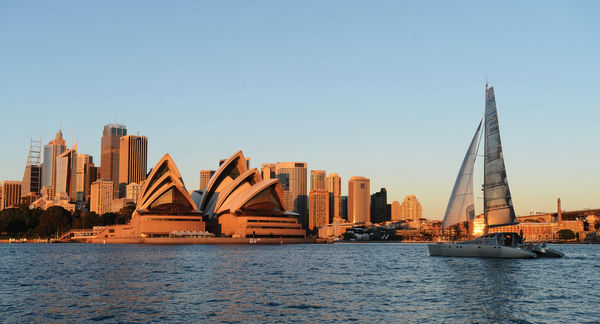
Issue #: 176
Published: March / April 2021
- Price per issue - digital : 6.50€Digital magazine
- Price per issue - print : 8.50€Print magazine
- Access to Multihulls World digital archives Digital archives
It’s a country! What am I saying? No, it’s an island, a continent! Seen from old Europe or the United States, it seems to be a homeland for multihulls. But what is it really? And where does such an attraction for two or three-hulled units come from? Between historical and geographical reasons, Multihulls World conducted the investigation. Above all, we discovered sailors, naval architects, boatbuilders - all of them passionate about it. It’s winter right now in the northern hemisphere, so welcome to the other side of the equator and summer in the great outdoors. We’ll take you on a journey of discovery to Australia.
Ancestors of our proas
I would have liked to tell you that the first Australians arrived by sea in proas, but this isn’t the case. They arrived from South East Asia, on foot, at the end of the last ice age. In 50,000 BCE, the land had less than a million inhabitants. A drop of about 500 feet (150 m) in the level allowed the first humans from Africa, present on the edge of what is today the Gulf of Thailand, to continue their conquest eastward. They were able, on dry land, to populate Indonesia, New Guinea and then Australia. Indeed, at the time, the whole lot formed only one continent, named Sahul. And it was on this arc that is now part of Oceania that evidence has been found of the first canoes with outriggers, looking surprisingly modern in design - the ancestors of our proas. These boats are more than 3,000 years old! European explorers of the 17th century who (re)discovered these regions were all impressed by the speed of the pirogues they encountered in the Pacific islands. Englishman William Dampier (1651-1715), the first to map part of the coasts of Australia, measured the speed: “18 knots over several hundred miles.” So, while we know Australia has multihulls in its genes, that’s clearly not something new!
One boat for every 24 inhabitants

But let’s look at a more contemporary period. Charles Lindsay, a dinghy builder, was also fascinated by traditional multihulls. In 1952, he designed the first prototype catamaran. Two years later, the final model was 20 feet long and took the pretty name Yvonne. The first national championship took place in 1956, and the “Yvonne 20” class still exists today, proof of a pencil stroke as ingenious as it was avant-garde. Needless to say that the Hobie Cat 14, designed in 1968, then its descendants - as well as its competitors - would find fertile ground in Australia. It must be said that climatic conditions, sociology and geography were particularly favorable here for the development of this new concept, which was booming in the 1970s: leisure activities in the sun and on the water. Australia has plenty of sunshine to offer, about 300 days a year in Brisbane, for example. This doesn’t come without creating a few constraints, though. Protecting oneself from UV rays is a must as this country is located under a huge hole in the ozone layer - Australia has one of the highest rates of skin cancer in the world. A bottle of sunscreen, mayonnaise version needs to be available for everyone on board. There is also saltwater all around, all along its fifteen and a half thousand miles (25,000 km) of coastline. 85% of the population (25,464,116 inhabitants) live on the coast, and the per capita boat rate is among the highest in the world: one boat for every 24 inhabitants, no less! Only the Scandinavian countries and New Zealand do better. We are therefore more at the level of the United States, but without the inland waters. And that’s five times more than France. So yes, Australia is a country of ...
What readers think
Post a comment
No comments to show.